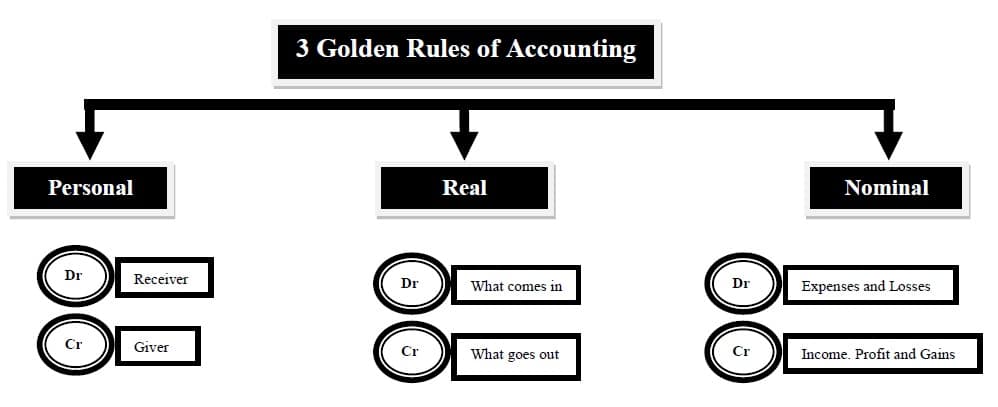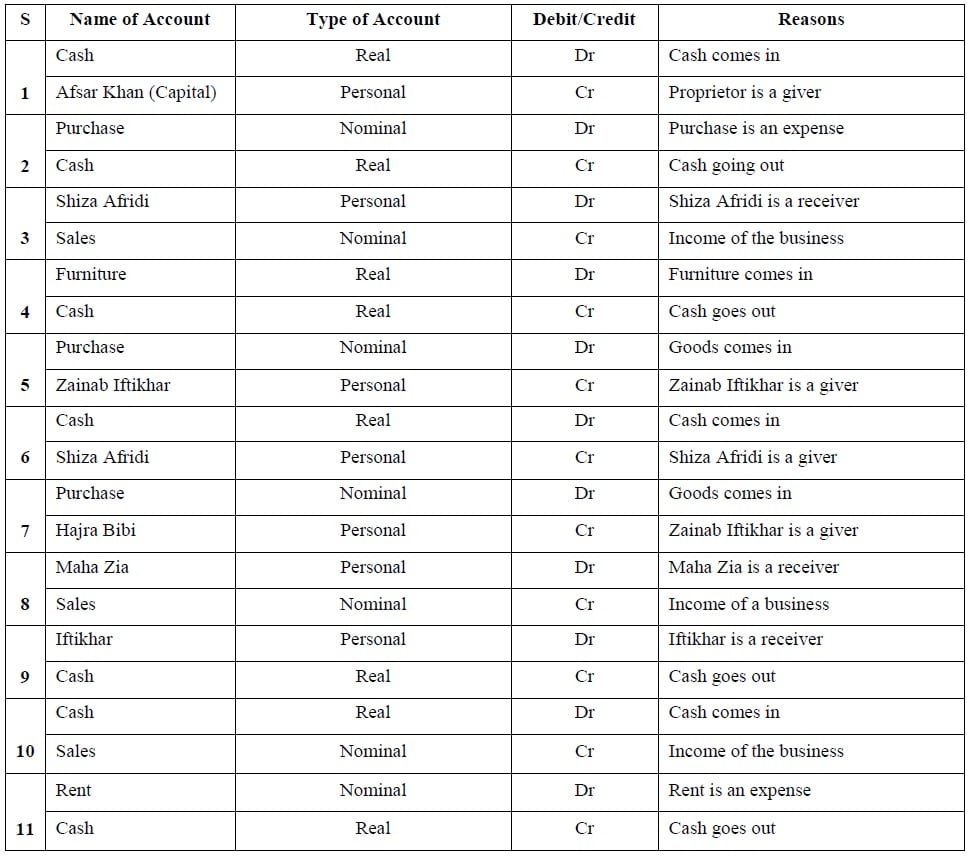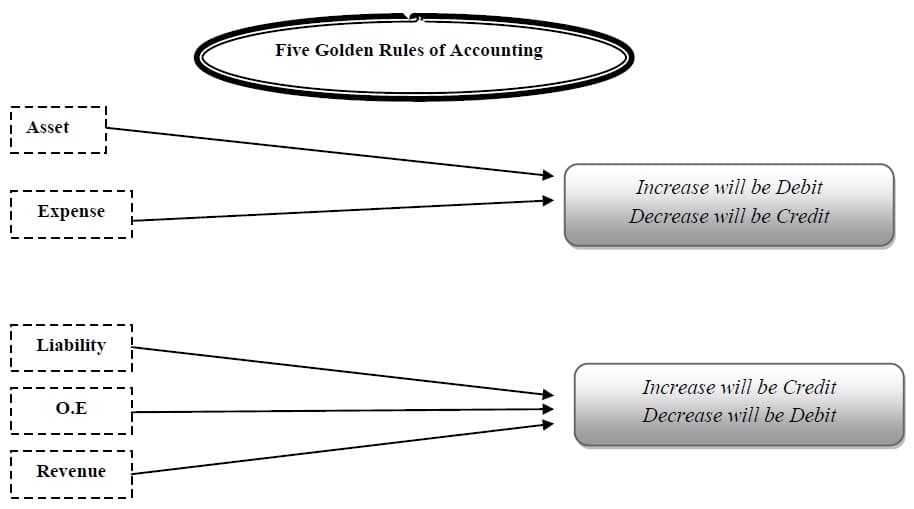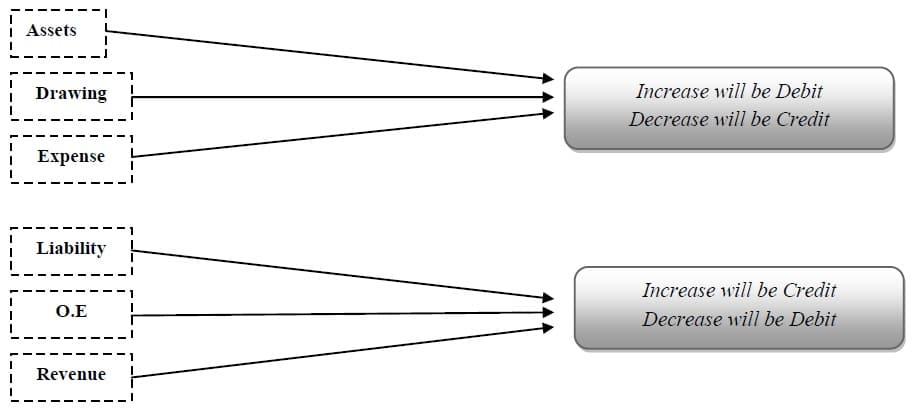Golden Rules of Accounting
Previous Lesson: Accounting Transaction
Next Lesson: Journal Entry
Golden Rules of Accounting are used to record economic activity in books of accounts. These rules are formulated on the basis of three basic accounts, personal, real and nominal account. An account is a summarized record of the transactions relating to one person or thing or one class of income and expense.
Debit is abbreviated Dr and credit is abbreviated Cr. The term debit means left, and credit means right. They do not mean increase or decrease. The act of entering an amount of the left side of an account is called debiting. Making an entry on the right side is called crediting. Golden rules of accounting are based on blow mentioned accounts which classified into three categories:
Three Golden Rules of Accounting
Accounting golden rules of debiting and crediting are designed according to three basic accounts:
1. Personal Account
Personal accounts are recording transaction with persons or firms. Those accounts recording transactions, which don’t affect particular person, but effects business in general, are called impersonal accounts. Personal accounts may be further classified into three categories:
- Natural Personal Account
- Artificial Personal Account
- Representative Personal Account
Natural Personal Account is an account associated to human like Amna Tabbasum, Usman Khurshid, etc. Artificial personal account is account related to any artificial person like XYZ Ltd, Ramin Trading, Asadullah Industries, etc. on the other hand, representative personal account represents a group of account. If there are a number of accounts of similar nature, it is better to group them like, rent payable account, salary payable account, and insurance prepaid account, etc.
In case of personal account debit the account of the receiver and credit the account of the giver.
2. Real Account
The Real Accounts are those accounts which show dealing in thing or of property or possession ‘Assets’ which are owned by the business organization. Such as cash, building, bank account, office furniture. Thus, asset account is called a real account. There are two types of real account:
- Tangible Account
- Intangible Account
Tangible assets are touchable assets having physical substance, such as machinery, stock, plant, furniture, cash, etc., and intangible assets are non-touchable assets such as patent, goodwill, copyrights, etc.
In case of real account debit the account of assets that comes in the business and credit the account of that which goes out the business.
3. Nominal Account
Since this account does not represent any personal or real account, it is called nominal or fictitious account. They relate to income, expense and gains or losses of a business concern. For example, salaries account, advertising account, discount account, sales account, and commission received account etc. These accounts do not have any existence, form or shape. All kinds of expense account, loss account, gain account or income accounts come under the category of nominal account.
All the business transactions are recorded on the basis of the following golden rules of accounting.
Activities:
Activity 1: Choose the best answer:
The receiving aspect in a transaction is known as?
Activity 2: Choose the best answer:
Capital account is classified under which of the following account?
Activity 3: Choose the best answer:
Nominal Account is classified under which of the following account?
Activity 4: Choose the best answer:
Goodwill is an example of the following account?
Activity 5: Choose the best answer:
Account Payable is an example for which of the following account?
Example 1:
Classify the following items into Personal, Real and Nominal Accounts.
1. Purchases 2. Cash 3. Drawings 4. Outstanding salary
5. Building 6. Rent 7. Account Payable 8. Discount received
9. Bank 10. Capital 11. Bank loan 12. Sales
Solution:
| S | Question | Solution |
| 1 | Purchases | Nominal Account |
| 2 | Cash | Real Account |
| 3 | Drawings | Personal Account |
| 4 | Outstanding salary | Personal Account |
| 5 | Building | Real Account |
| 6 | Rent | Nominal Account |
| 7 | Account Payable | Personal Account |
| 8 | Discount received | Nominal Account |
| 9 | Bank | Real Account |
| 10 | Capital | Personal Account |
| 11 | Bank loan | Personal Account |
| 12 | Sales | Nominal Account |
Golden rules of accounting with examples
March 2018
- Siam Afsar Khan started business with cash Rs. 250,000.
- Purchase goods for cash Rs. 15,000.
- Sold good to Shiza Afridi Rs. 5,000.
- Purchase furniture for cash Rs. 30,000.
- Bought goods from Zainab Iftikhar Rs. 45,000.
- Received from Shiza Afridi on account Rs. 3,000.
- Goods bought from Hajra Bibi Rs. 10,000.
- Sold goods to Maha Zia Rs. 8,000.
- Paid to Zainab Iftikhar Rs. 25,000.
- Sold goods for cash Rs. 12,000.
- Paid rent of shop Rs. 17,000.
Solution:
Five Golden Rules of Accounting
Accounting rules are also classified as “5 Golden Rules of Accounting”, which include asset, liability, owner’s equity, revenue and expense.
1. Assets
An asset is worth item of the business, which it can use in its business operations. Assets are of economic value to the business, and can be expressed as a dollar value; assets are what the business owns. There are two classifications of assets:
- Current Assets and
- Non-Current assets
Current assets are assets (future economic value) of the business that will be consumed, or used converted into cash within the next 12 months. For instance, cash in hand, cash at bank, stock, accounts receivable, prepaid, etc. On the other hand, non-current assets are assets of the business expects will still be in use after a year, and not used or converted into cash with in 12 month. Examples of non-current assets are buildings, land, machinery, vehicles, office equipment, investments, etc.
Liabilities
A liability is an obligation of the business that it must eventually repay in the future. Liabilities are what the business owes outside to the business organization. There are two classifications of liabilities, such as:
- Current Liabilities and
- Non-current liabilities.
Current liabilities are obligations that the business is required to satisfy within the next 12 months. Such as accounts payable, payable and outstanding etc. Non-current liabilities are obligations that the business is required to satisfy or pay after or beyond 12 months, for instance, mortgages, bank loan (more than a year), mortgage loan, etc.
Owner’s Equity
Owner’s equity is what the business is worth. It is what the owners have put into or invested in the business; another words, we can say that it is an internal liability of business organization, as it shows what the business owes to the owner. The words ‘proprietorship’ or ‘equity’ or ‘capital’ means the same as ‘owners’ equity’. Examples of owners’ equity are capital, drawings.
Revenue
Revenue is the earnings, proceeds or takings from the operations of a business. The word ‘income’ means the same as ‘revenue’. For example, commission received, sales, fees, interest received, and rent received etc.
Expenses
Expense is what is incurred or spent in making the sales, and in running the business. For our purposes, ‘cost’ means the same as ‘expense’. Examples of expense are cost of goods sold, wages or salaries, rent expense, postage expense, and stationery expense etc.
5 + 1 Golden Rules of Accounting
If we add one more accounts (Drawing) to previous classification. These six types of accounts arrange alphabetically as described in below diagram:
Using accounting scale, first three accounts are debit balance account and show in debit or left hand side. Similarly, other three accounts in accounting pillars are show in credit or right hand side, as below:
Now account golden rules are described in below mentioned diagram:
>> Read Accounting Cycle.
References
Maheshwari, S. N., & Maheshwari, S. K. (2009). Financial Accounting. (5th, Ed.) New Delhi: Vikas Publishing House Pvt. Ltd.
Maheshwari, S. N., & Maheshwari, V. L. (2009). Advanced Accountancy (Vol. I & II). New Delhi: Vikas Publishing House Pvt. Ltd.
Mukharji, A., & Hanif, M. (2003). Financial Accounting (Vol. 1). New Delhi: Tata McGraw-Hill Publishing Co.
Narayanswami, R. (2008). Financial Accounting: A Managerial Perspective. (3rd, Ed.) New Delhi: Prentice Hall of India.
Porwal, L. S. (2001). Accounting Theory. New Delhi: Tata Mcgraw Hill Publishing Co. Ltd.



















We are a group of volunteers and opening a new scheme in our community. Your website provided us with valuable information to work on. You have done an impressive job and our whole community will be grateful to you.
Hey very cool web site!! Man .. Excellent .. Amazing .. I’ll bookmark your website and take the feeds also…I am happy to find a lot of useful information here in the post, we need develop more strategies in this regard, thanks for sharing. . . . . .
Hello Dear ! I am interesting to this site so after today i want to the member of this site.
Thank You !!!
Sir, Which transaction are recorded in debit side in journal, but these transaction are changed in credit side in ledger. Why it is change?
Thank you so much for you because your explanation is very useful to me.
Thank you so much for this rule. its very helpful for everyone.